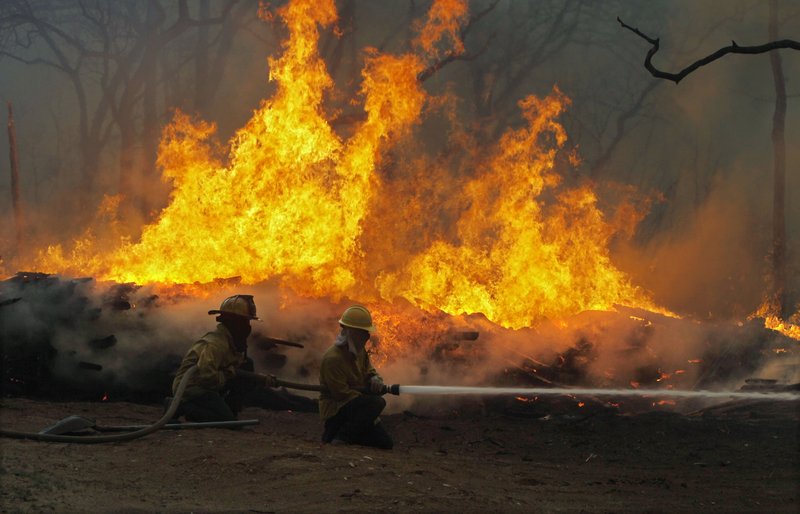WASHINGTON – Hot, bone-dry and unrelenting.
Such were the conditions across Kansas for much of 2012. Kansans have rarely seen anything worse, and that’s a powerful notion in a state buried under the Dust Bowl eight decades ago and which suffered epic droughts in the 1950s and 1980s.
Prospects for the near future don’t look much better, and state officials are well aware of the reality. “No matter how you say it, conditions are dry, and there’s no positive outlook,” says Tracy Streeter, who heads the Kansas Water Office.
Streeter’s counterparts in much of the country offer their own versions of that bleak forecast. From the slow-moving, suffocating drought that wreaked havoc on crop conditions, to quick-punching, deadly tornadoes and tropical storms, many states are still picking up the pieces from 2012 — while debating what’s on the horizon.
In Kansas and Texas, that means pushing water conservation and weighing investments in infrastructure that could tap new supplies. States in the West will be looking for ways to prevent or neutralize destructive wildfires that have accompanied the hot, dry weather. Along the hurricane-ravaged Mid-Atlantic coast, where policymakers are finally getting relief from Washington, questions loom about where and how to rebuild along the seashore.
But many states looking to guard against extreme and unpredictable weather are simultaneously struggling to fund basic government services. With that backdrop, states will aim to boost resilience using fewer resources.
Almost every state was touched by major natural disasters in 2012. Only Maine, Michigan, Vermont and Wisconsin were left unaffected by weather events that had costs exceeding $1 billion, according to data from the National Oceanic and Atmospheric Administration.
NOAA is still calculating the financial blows dealt by Hurricane Sandy and the near-nationwide drought, but those damages are almost certain to make 2012 one of the costliest years on record.
With Kansas at the epicenter, the drought at its peak gripped about two-thirds of the continental U.S. It killed 123 people and destroyed billions of dollars’ worth of crops and cattle, elevating food prices. It still lingers across more than half the country.
Last year was also the nation’s hottest on record, creating prime conditions for wildfires. Some 9.2 million acres — mostly in the West — were destroyed. That total includes Colorado’s Waldo Canyon Fire, which devoured some 340 homes in just four hours. Only two years in recorded history have seen more acres burned in the U.S.
But Sandy was the year’s deadliest disaster. Churning up the East Coast in late October, its powerful winds and rain — and the flooding that came with them — overwhelmed some of the nation’s largest population centers, killing 131 people, destroying thousands of homes and businesses, and cutting off water and electricity to millions of people.
Sandy will echo loudly in legislative chambers as East Coast state officials continue recovery efforts while considering how best to prepare for the next major storm — whenever it may come.
Calls for more cautious coastal management are hardly new. But last year’s vivid examples of what can go wrong have turned up their volume.
• In Maryland, Gov. Martin O’Malley last month ordered state agencies to consider sea level rise and flood risks, using updated guidelines, in all new and rebuilt state structures.
• New York Gov. Andrew Cuomo has launched expert panels to study coastal infrastructure and the state’s emergency response capabilities.
• In New Jersey, where Sandy damaged or wiped away some 340,000 homes, storm response will take center stage in the 2013 legislative session. Most notably, lawmakers will weigh how quickly and carefully to rebuild along the state’s battered coastline.
• In Kansas, where river levels have hit historic lows, policymakers say they are preparing for the worst, and asking local officials and farmers to grit their teeth and do the same.
Send questions/comments to the editors.



Success. Please wait for the page to reload. If the page does not reload within 5 seconds, please refresh the page.
Enter your email and password to access comments.
Hi, to comment on stories you must . This profile is in addition to your subscription and website login.
Already have a commenting profile? .
Invalid username/password.
Please check your email to confirm and complete your registration.
Only subscribers are eligible to post comments. Please subscribe or login first for digital access. Here’s why.
Use the form below to reset your password. When you've submitted your account email, we will send an email with a reset code.